The Squeeping Catterwhip is now finished and is now available to buy from Amazon!
I’m publishing this commentary on the art here as an egocentric insight into the creative process as well as a sneak preview!
I’m also posting the text of the poem verse by verse and although I will refer to things like quippets and pattersnips, I’m pretty sure you’ll be able to match the words to the action and characters in the scenes!
The Squeeping Catterwhip : cover art
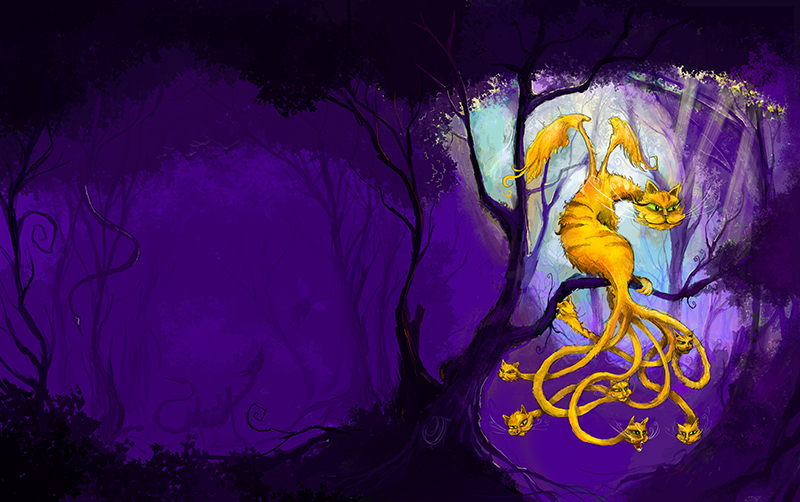
I knew that I wanted this image for the front cover as soon as I finished it – it’s a variant on the art for verse 5 below. I edited out the loaf of blapper and the Wishangrope as I felt that they’d confuse readers who had no idea what they were, so this is also the ‘cleanest’ view of the titular character.
As soon as I’d finished the cover, an editor from one of the big publishers made a Tik Tok style tweet stating that purple is an absolute no-no in picture books because apparently someone in marketing doesn’t like it.
Too late for changing the palette now, and purple is great, so marketing people be damned!
Opening spread (1)
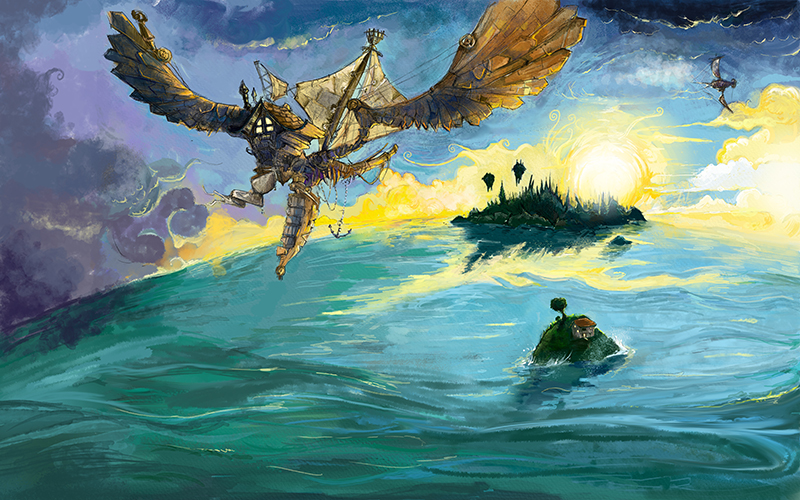
This was the last of the wordless spreads that I worked on. The concept was to properly set the scene to the readers and not to just drop them into the poem in this strange world. I felt that I needed to show the island that the story takes place on “A gawdzillion miles at sea” and the first spread that I drew (the following page) was an inland view.
The winged boat is a design I’ve always loved ever since I saw the Winged Terror of Tzeench in the rules for Warhammer Man-o-war. It’s the ship that’s supposedly bringing the reader to the island. I’d decided by this point that the Wishangrope (the main character) would be an inventor of sorts, or at least that the world has some kind of proto-steampunk technology and this ship seemed to be a good balance between monsters and fantasy and steampunk (and I had also been playing Monster Hunter World, which was probably been a bit of an influence on the worldbuilding).
The curvature of the world is there for three reasons. 1. It makes it look more interesting 2. It makes the world look a bit smaller – I had an idea of this was one of a whole cluster of pocket-sized planets all orbiting one another 3. It would annoy the flat-Earthers
The little house was influenced by the train scene in ‘Spirited Away’ – I love the visuals of the tiny islands marooned in the sea with just a train track running through it.
Opening spread : setting the scene
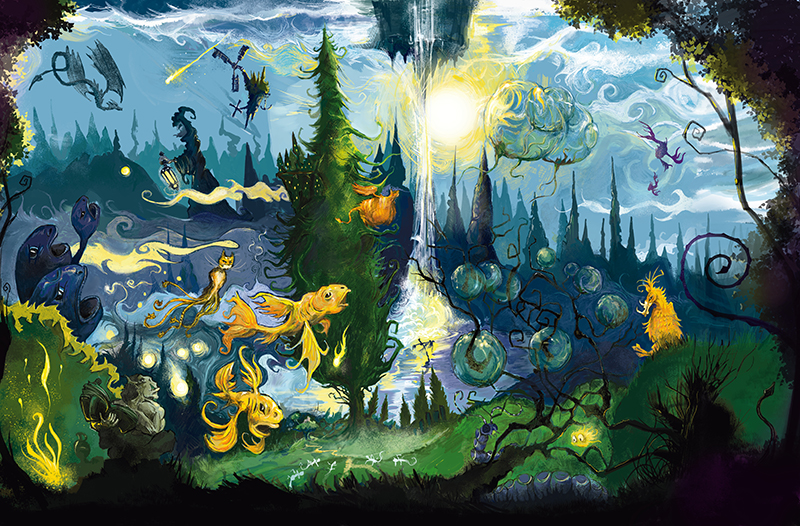
This was the first drawing I worked on for this project. My first decision was that I wanted a single wordless spread for scene-setting. If the poem hadn’t been in nonsense verse I may not have done this, but there was potentially so much to alienate readers that I felt that as much introduction as possible was necessary.
At this point I was working with just the first couple of lines, and especially “In a land of slivenish creatures”. My interpretation was that ‘slivenish’ was a kind of collective term, when actually Michael had envisaged the sliveners as a single type of creature (my fault for not properly reading the whole poem, though to be fair, pretty much everything else was entirely undefined at this stage). Anyhow, this is a double page full of a range of creatures that I felt would be at home in this world, almost none of which we’d see again in the book, but what they do is cement the idea that this is a living breathing world.
The silver sliveners at the bottom of the image approaching the Wishangrope’s home are a very late addition to tie this into the previous and next spreads that ‘zoom in’ to the scene illustrating the first verse. Actually, the only creatures that I originally drew here that made it into the poem as characters were a prototype of a Zuider Zee and a prototype of the Catterwhip. The vegetabubbles come into the world fully-formed.
I’d envisaged the world as mythical rather than based on realism, hence creatures like the dirigible mog and the lamplighter (who puts up and takes down the stars).
The megapine stayed as a fixture in the landscape. I’d imagined it to hold a the only town on the island in the form of a giant treehouse.
The floating islands can be seen again here (with a waterfall). These were a hangover from an early idea that the sky would be another ocean with waterfalls and waterrises linking it to the sea. I abandoned this in the end thinking that it would probably cause more problems than it would be worth.
What did stay was the sunrise. When I started colouring it I realised that the light indicated that it was the morning and it occurred that I could have a closing spread at sunset. This was not just an excuse to draw another double page of creature and scenery designs, but also an excuse to put off delving deeper into the poem and working out what on Earth a pattersnip looks like. In the end it was worth it, as the final night-time scene features the first drawing of a slivener.
Opening spread (3)
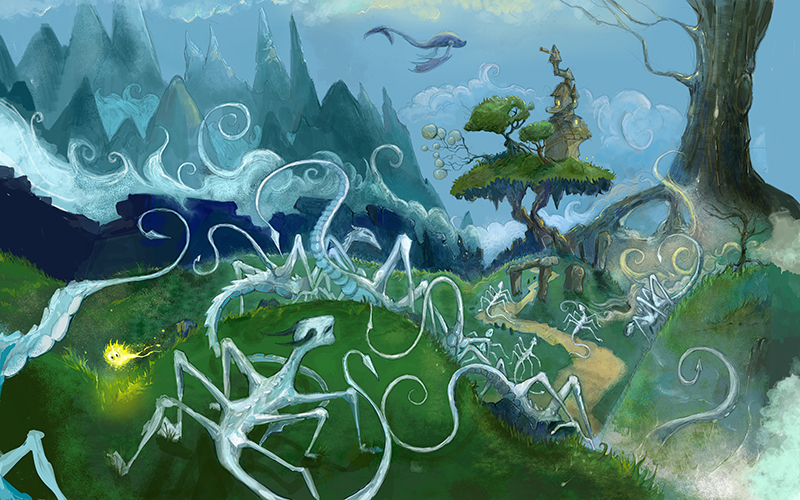
The final ‘zooming in’ before we get to the poem proper and the first view of the ‘army of sliveners’ coming though the early morning mist.
Verse 1

“In a land of Slivenish creatures
Twenty gawdzillian miles at sea
There lives a Dervilish Wishangrope
And his family of Zuider Zees”
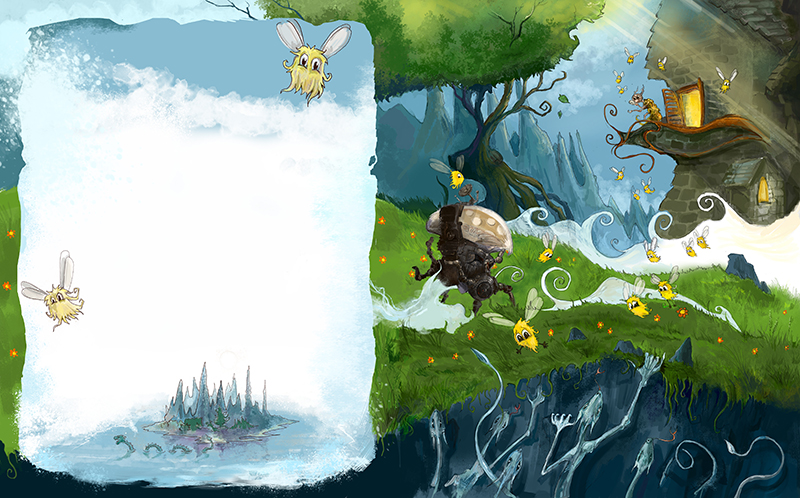
We’d both agreed on the text being on the left page and the illustrations on the right. Originally there was no blending between the two, then I went through drafts of watercolour-style backgrounds, but the pages just didn’t match. In the end I bit the bullet and extended every page into a spread with an overlay over the left side for the text so it still allowed me to do little designs expanding on some of the characters and objects.
This illustration was actually the final verse I illustrated for the book because Michael wrote a new second verse (which we realised was needed to properly set up the story). When I set out illustrating this, it occurred to me that my original art for verse one was better suited to the new verse two, so I now needed new art for verse one.
I think this is far better suited, especially as it’s a less dramatic scene than the next, and introduces the Wishangrope, and Zuider Zees.
Verse 2
It seems that an army of Sliveners
Have interpolated the Fractured Spracket
Of the Wishangrope’s inimitable Quippets
And will most certainly try to crack it
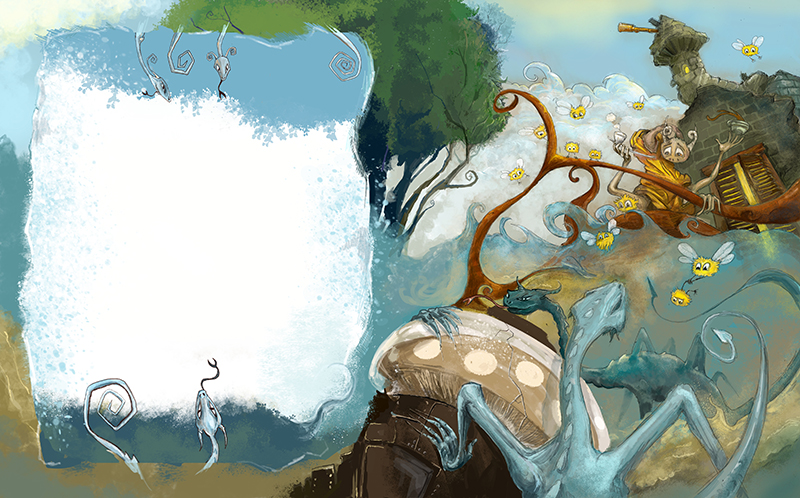
This page is one of my favourite illustrations in the book. The dramatic quality is definitely more suited to the verse – Michael only introduced the Quippet and Fractured Spracket very late in the day as the ‘missing link’ as to why the Sliveners were at the Wishangrope’s door. The original only shows the Sliveners climbing up to the house, but it wasn’t difficult to add in the new elements.
Aside from the wordless spreads, I illustrated the rest of the poem in order so as to ensure continuity as I invented characters and objects. At this point, I only knew that I wanted the Catterwhip reveal to be similar to my earlier sketch. I also knew that I wanted the whole poem to progress over the course of a day, so that we’d end the poem at sunset to match the final spread. I knew that the Wishangrope would be going on a journey, and showing the passage of time would help with getting a feeling of distance travelled and that this isn’t a quick trip, but a quest!
To develop the look of the characters and objects in the poem (Michael gave me total free-reign) I latched on to any recognisable word or words within their names. I felt that this would be something that the readers could latch onto and help bring them into the world. For example, I felt it would be counter intuitive if a CATterwhip looked like a wolf – even if it was only on a subconscious level, a reader would expect something either cat-like or (possibly) caterpillar-like.
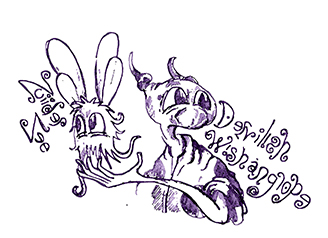
From Wishangrope I took ‘wish’ and ‘grope’. Now, grope has negative connotations these days – usually associated with abuse. I went for the traditional use,as in to reach out or feel for something, hence it has lots of hands. My first drawing only showed it from the waist up, but by the next page it occurred to me that it didn’t need legs, just lots of arms. The shapeless robes made it unnecessary to work out what shape it’s body was. I wanted the Wishangrope to always be holding onto some object or other, hence the pipe and cup of tea.
I never drew a mouth because I didn’t want recognisable human expressions – its eyes are expressive enough and it’s certainly not human.
I made less of the ‘wish’ part of the name, though I imagined it as a faerie tale (not fairy tale) type character. Not a trickster as such, but certainly someone very clever and resourceful and almost mystical, which is where the inventions and the style of house came from. As the Wishangrope is being threatened, I also needed to make it seem quite vulnerable.
The horns are there because I’d interpreted ‘dervilish’ as ‘devilish’ – not because I wanted people to think it evil, though, but in a traditional ‘wild’ sense, like the god Pan. The wishangrope is very earthly, pagan and close to nature.
‘Zuider Zees’ just sounded like ‘bees’, and from the poem I visualised lots of them, so a swarm of bees seemed appropriate. I wanted them to look sweet, rather like the furry bumble bees in my garden that my daughter always used to be attracted to and wanted to stroke.
The words Sliveners, or Slivenish Creatures, reminded me of silverfish, or slithery. The silver-grey lizard I’d drawn seemed to fit the bill. It looked sinister enough to be a villain and the legs gave it an angular, tensed look. I didn’t want to go with serpents because they get a bad enough rep at the best of times. I toyed with the idea of literal silver fish (not the grubs you get in old carpet), but fish only look really menacing when you turn them into piranhas, or sharks or some kind of over-designed deep sea horror, and for a picture book I needed something more subtle than a H R Giger-like creation.
Verse 3
So, the Wishangrope places his Pattersnip
Upon his Bolden Firm Influcter
Securing it with a Newlish Crachet
And a secondhand Reimpucter
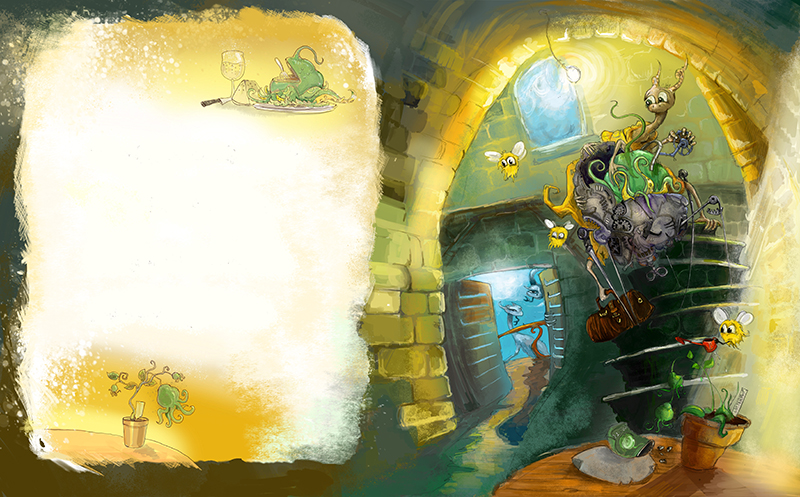
Drawing stalled here for a while, and my trouble with this page is the reason why there’s a first page with a winged ship. I was having lots of difficulty with what a Pattersnip looked like, or even whether it was animal, vegetable or mineral. My first idea was to break the word into ‘parsnip’ and ‘patter’. Patter could be talk, or the patter of feet, and so I drew a parsnip-like vegetable on legs. The trouble is, not only did this not look particularly great, nothing I came up with seemed to fit in with the rather curious use of the pattersnip later on.
In the end I admitted defeat and got into an email exchange with Michael over how he’d visualised what a pattersnip was. Time difference meant that I had a few more evenings to paint the sky ship as we threw ideas back and forth. Michael had also imagined it as being a vegetable of some kind – or at least something edible, a delicacy. Also, my confusion over whether it was alive and a character or not stemmed from a typing error which mistakenly replaced ‘Wishangrope’ with ‘Pattersnip’ in the penultimate verse (stating that the pattersnip was who took he loaf of blapper to the sliveners).
Now confirmed as a vegetable, I kept it as a ‘neep’, but made it turnip-like rather than parsnip-like. Michael had described it being the size of a watermelon, and a large turnip fitted the bill. I made it green as I felt it looked more interesting and I couldn’t resist giving it octopus tentacles. I’d got used to it being ambulatory, and wanted to make it a bit more fun.
It was at this point that I introduced the Wishangrope’s penchant for strange inventions. Cratchet and reimpucter and influcter didn’t sound like anything other than machines or devices to me, so I designed something suitably strange and clockwork, and that would belong in a tree house in a fantasy world. I honestly have no idea why the Bolden Firm Influcter needs to travel via vegetabubble and yet can walk and run…
Verse 4
Off he dispatchels with the Zuider Zees
Crammed in their Vegetabubbles
To visit the Squeeping Catterwhip
About these vexing Slivenish troubles
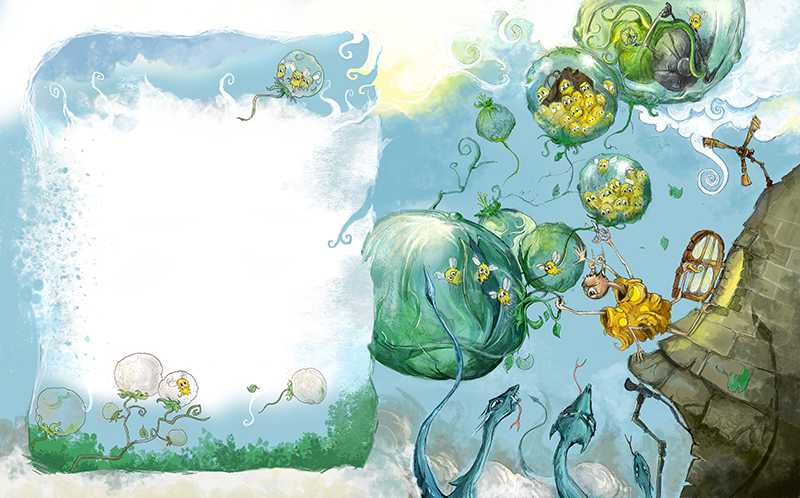
The vegetabubles scene practically drew itself. If I hadn’t already added a loft window to the house, I’d have added one in order to give the verticality the Wishangrope’s escape needs. I’m unashamedly proud of the unbelievably cute Zuider Zees crammed together in the bubbles. I also settled on six arms for the Wishangrope which conveniently add some extra frenetic activity as they hold onto the window and help the Zuider Zees escape.
Verse 5
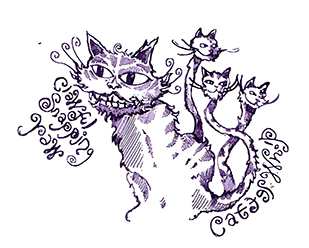
But the Catterwhip is terribly busy
Polishing her Clawful Snapping Yaw
With a clumbersome loaf of Blapper
Nearly slapping the Squeeper raw
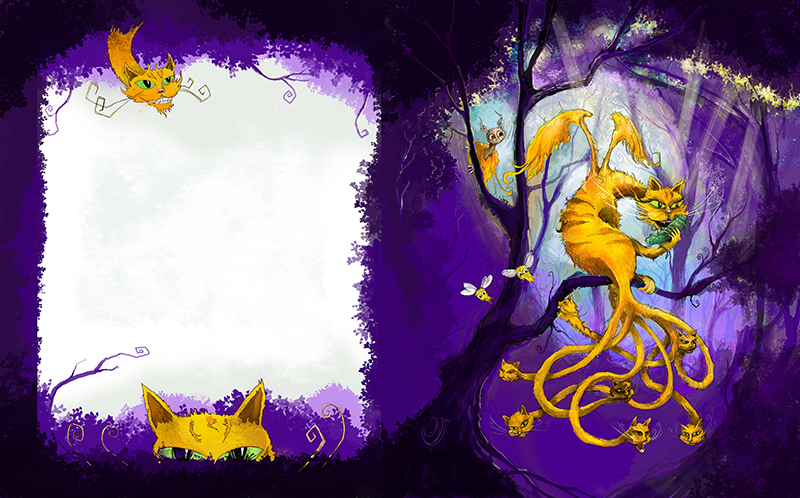
Arguably this was the first page I designed, even if I only worked on it now. The original Catterwhip was much angular in its pose and looked a lot more threatening. At the time of doing the original sketch I’d been told that the poem was inspired by The Jabberwocky and so I equated the Catterwhip to the monster at the end of the quest. Once I’d discovered what the Catterwhip was, I knew I needed to soften the tone considerably. As it is, she’s still intimidating, but much less scary.
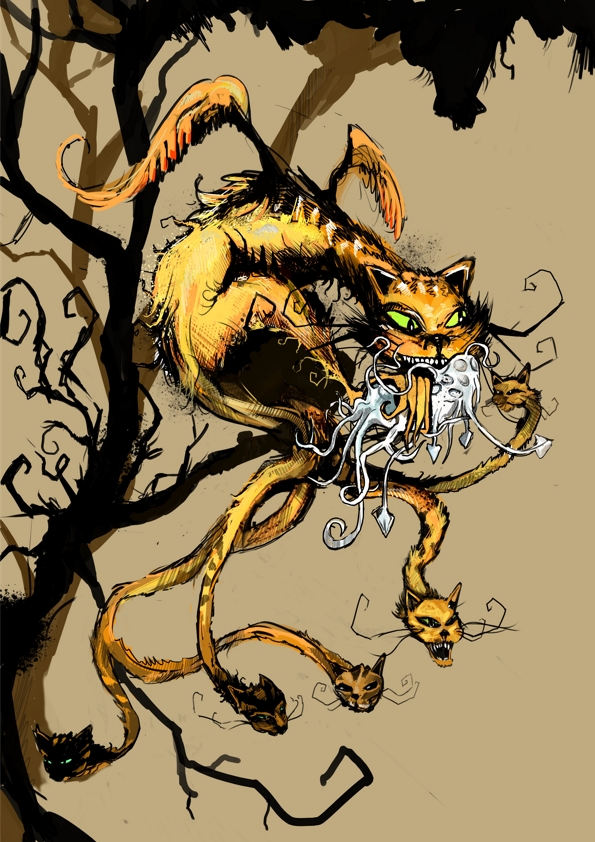
I read ‘Catterwhip as ‘Cat’ and ‘Whip’ – which conveniently became a cat-o-nine-tails (although she doesn’t have nine). I’m not sure why I put her in a tree originally, but I gave her wings so that she wouldn’t get stuck. I was also probably influenced a little by moogles.
The background was a reworking of a pen and ink drawing of Red Riding Hood that I’d done a few years ago. I liked the idea of her being a hermit or a Totoro-style creature of sorts and the setting of a deep forest is always a good place for a quest to lead. On the other hand, it did scupper a little my idea of showing the changing time of day for a few pages.
It wasn’t until Michael wrote the glossary that I found out that Catterwhips are a species.
Verse 6
So, the Wishangrope buys a Smachet
For his Jeerful Clap of Pattersnip
And wraps it in a Mandled Baitertrap
To entice the Squeeping Catterwhip

Obviously if you’re in a deep forest, you can’t just go to the corner shop for some mandled baitertrap. I ought to ask Michael whether he envisaged this in a town rather than the wilderness… I was playing ‘Lego Worlds’ at the time, and during the game a character called the Balloon Trader appears and so I shamelessly borrowed the idea – I think the shopkeeper here is a kind of Meerkat. The baitertrap is a long ribbon of pressed cured meat – a bit like Italian antipasti. If you’re vegetarian it’s pressed dried fruit.
Verse 7
When the Catterwhip sees the Pattersnip
Wrapped up in the Mandled Baitertrap
She ceases polishing her Clawful Yaw
Nearly snapping her Blapper in half!
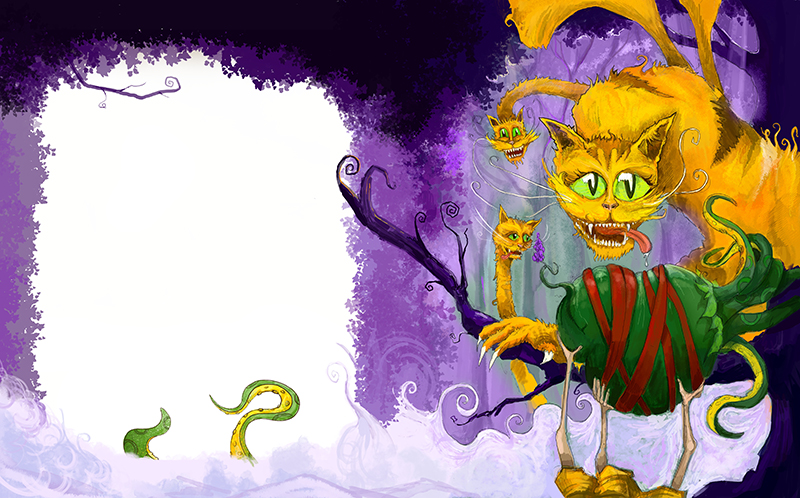
It was at this point that I started to think “This whole forest setting is playing havoc with the showing the passage of time with the sun.” I’d started expecting the whole story to have a lot of blue skies and green landscapes, however playing around with the palettes, I realised that I didn’t want the traditional green forest and that the purple not only let the Catterwhip stand out, but also added a real otherworldly feel to things. It also differentiated the settings – we know that the Wishangrope has had to travel quite a way from home.
Verse 8
After hearing the case of the Sliveners
And the troubles of the Wishangrope
The Catterwhip verily ponderates
Peering deeply into her Fibrilloscope
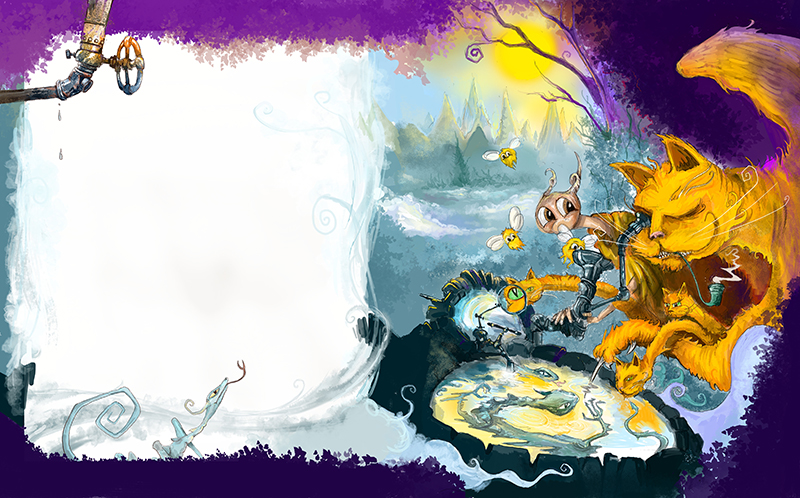
Scrying pools are brilliant and I borrowed this one from Time Bandits. I’d been told that the Catterwhip was using her fibriloscope, and I felt this was far more interesting that some kind of telescope or oscilloscope. It also enabled me to show what she was looking at and to have the other characters join in.
Everyone smokes pipes here, by the way. Pipes are very civilised things and as Bill Bailey said on QI, “You can’t properly give directions without a pipe in your hand.”
True story – I was party to a number of SCBWI authors who were discussing whether it was safe to write about children in their books drinking Lucozade as it’s a sugary energy drink. Their heads would probably explode if they saw this. And that’s a good thing.
Also in this scene I FINALLY get to show the sun again – just in time for it to set!
Verse 9
The solution comes in a Flashcan of Gurples
The Catterwhip squeeps in rapturation!
“Take this combobulated loaf of Blapper
to the Sliveners as an invoculation!”
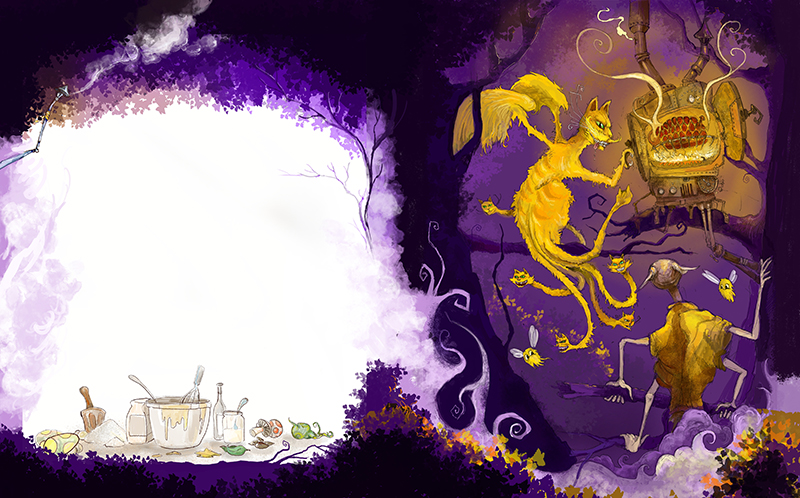
I was given the phrase “a flashcan of gurples” and also the object “a combobulated loaf of blapper”. I took the flashcan to mean a lightbulb moment, but I was already using an oven to bake the loaf of blapper, so it became the flashcan. I can’t guarantee that no pattersnips were harmed in the making of this loaf.
Verse 10
The Wishangrope takes the loaf of Blapper
Securing it with his Newlish Crachet
And an extra turn of the Reimpucter
For a Zuider Zee to dispatch it
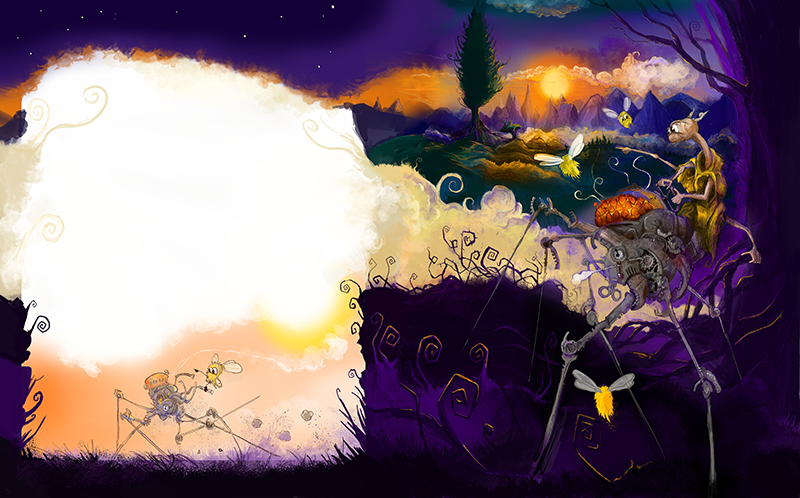
The sunset shows that our story is nearly at an end as the Zuider Zee takes the loaf to the sliveners to placate them…
There was something about this scene that I felt a little unsatisfied about, and I think it was because Michael and I had slightly different interpretations of this verse. Ironically, this only became apparent to me when I made a suggestion for anew verse 11 which would have shown the Zuider Zee arriving home and presenting the loaf to the sliveners. It seemed that Michael had envisaged the Wishangrope, Zuider Zees and the loaf to return home together in the vegetabubbles, and apparently it was just me who thought that the Zuider Zee had taken the influcter home on it’s own. Hence why we got a new epilogue, rather than a new verse 11!
Verse 11
Their Slivenish troubles verily solved
Twenty gawdzillian miles at sea
They hop back into their Vegetabubbles
The Wishangrope and his Zuider Zees
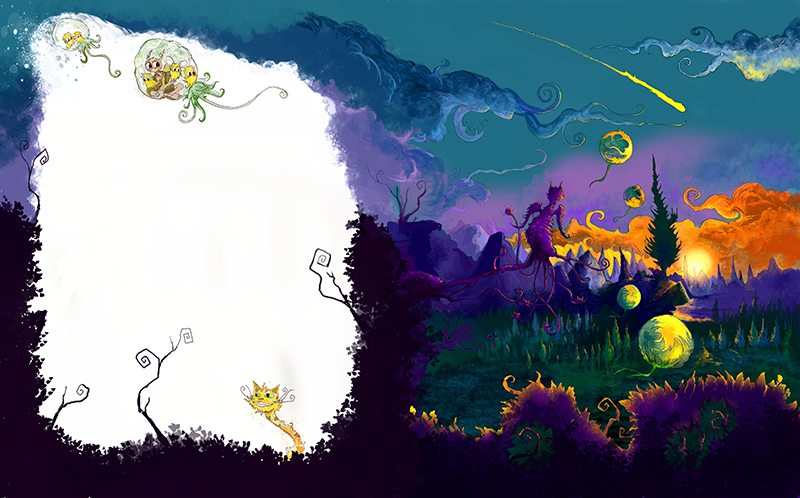
I painted this scene whilst having a bit of a miserable Christmas suffering with Covid, but somehow I turned this one into a scene that I absolutely love, especially the colours and how the clouds look. I drew the megapine from the reverse side, showing the direction that the Wishangrope has travelled. The Catterwhip in the tree was a bit of a Totoro-inspired moment, with the characters journeying off into the sunset.
This page originally came out far too dark in proof, but fortunately I was able to lighten it without it looking washed out.
Epilogue
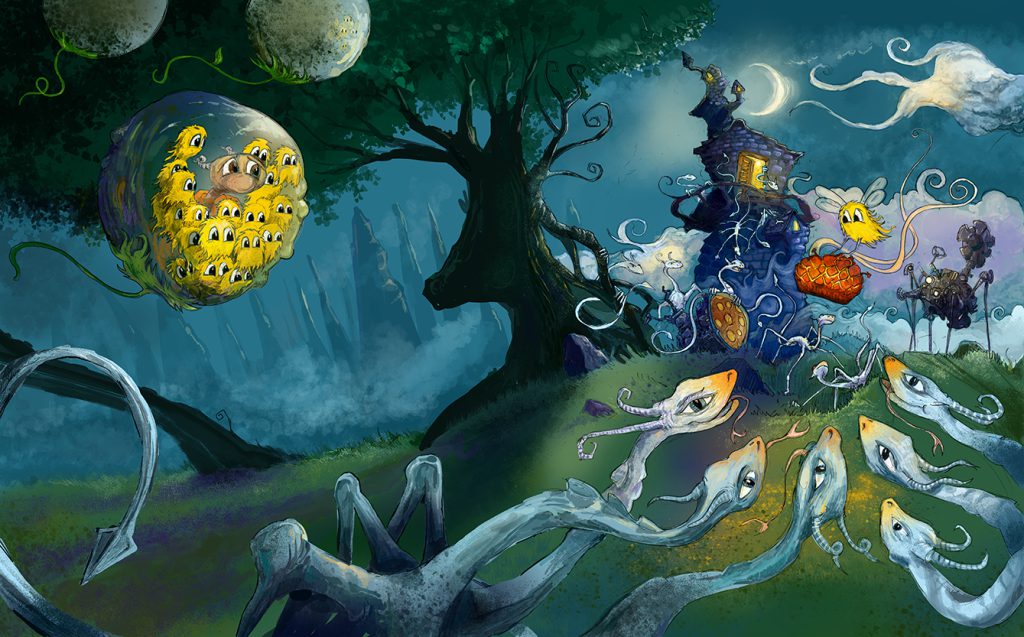
I actually drafted a verse for this, as this is the image I’d intended for a new verse 11 showing the sliveners being placated. This was the final drawing I completed for the book, weeks after we thought we’d finalised things. I drew it because I really felt that we needed at least a hint at the results of the Wishangrope’s quest. I also wanted the reader to see that it all worked out and that the sliveners had left the Wishangrope’s home and not eaten the quippet! I’m glad this scene was post-sunset, as the glow of the loaf is much more apparent – originally I’d envisaged the loaf with the setting sun behind it.
Closing spread
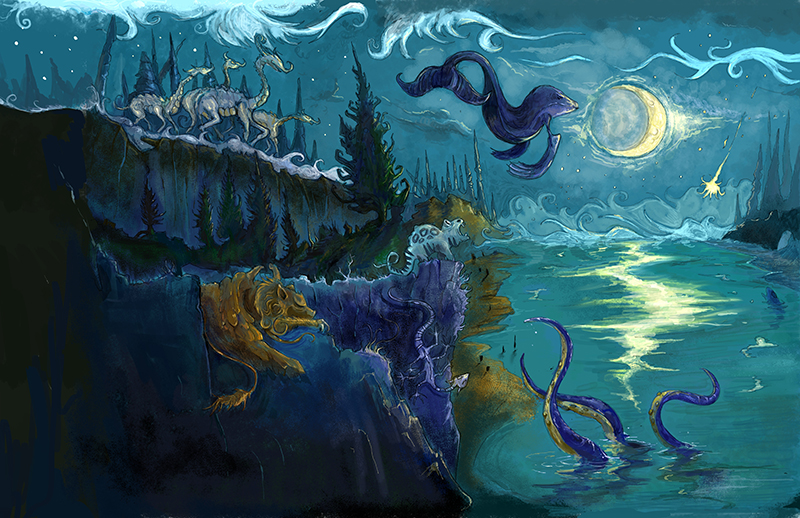
We approach the glossary with what was the second drawing I did for this book and what I’d always intended to be the other bookend. It’s the first sight of a slivener but again no other creatures make an appearance in the story! Looking back, I’m satisfied that even though from start to finish this took a year to complete, my art style hasn’t changed too dramatically. What is noticeable is that the first spreads to be drawn were both done on an very old HP Powerbook with touchscreen and stylus that kept freaking out and crashing. I knew I’d never be able to complete a project like this on my Intuos, and so I bit the bullet and bought a Huion Kamvas Pro, without which I doubt this book would exist as it does now.
Final pages

Just because of a quirk of the KDP layout (they add a final page with a barcode on it) I decided to add a final image after the glossary and the meet-the-author page. It’s a night-time equivalent of the sky-ship scene at the start. The two tuxedo cats on the prow are the wonderfully named Bish and Bosh – my two rescue cats who have informed most of my cat-themed art and who were both sadly lost during 2020 and who inspired me to create BishBosh Books.
And that’s it! Thank you for reading this monster post!